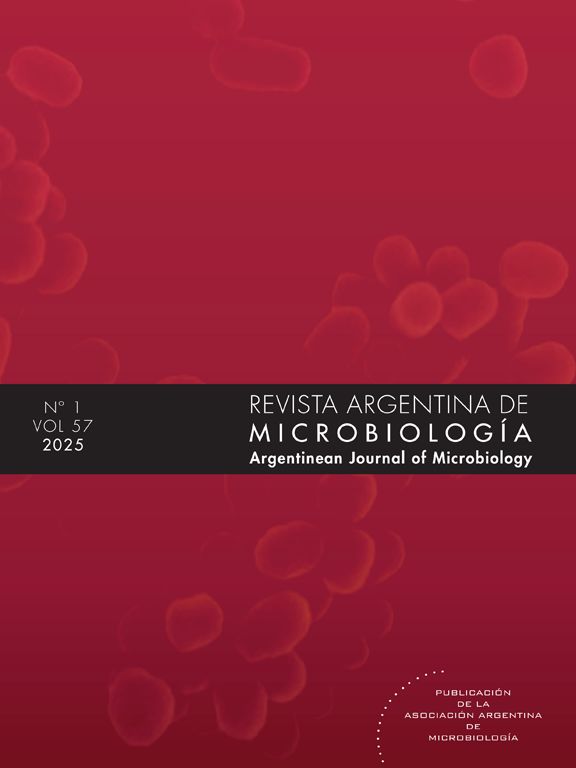25953
Candida albicans the main opportunistic pathogenic fungus in humansIgnacio Uriel Macias-Paz, Salvador Pérez-Hernández, Alejandra Tavera-Tapia, Juan Pedro Luna-Arias, José Eugenio Guerra-Cárdenas, Elizabeth Reyna-Beltrán
Rev Argent Microbiol. 2023;55:189-98
25953
Highlights
- •
Candida albicans is the main opportunistic fungus of humans.
- •
Eno1, Pgk1 and Als1 of C. albicans have significant immunogenicity.
- •
Virulence factors involved in the pathogenesis of C. albicans.
5570
Molecular detection of SARS-CoV-2 in Argentina: Evaluation of alternative diagnostic tools for the decentralization of the diagnosisGonzalo Manuel Castro, Paola Sicilia, Robertino Gierotto, Julieta Sosa, Andrés Marcos Castellaro, María Gabriela Barbás, María Belén Pisano, Viviana E. Ré
Rev Argent Microbiol. 2023;55:206-13
5570
Highlights
- •
Tested SARS-CoV-2 molecular assays showed good performance and allowed decentralization.
- •
The 9-min RNA extraction was the less time-consuming method yielding quality results.
- •
FlashPrep® reagent showed excellent results to perform direct RNA detection.
- •
Isothermal amplification assays showed acceptable sensibility and specificity.
- •
All the assays were useful for detection of the COVID-19 waves in the central region of Argentina.
4834
Contaminantes microbianos en cervezas artesanales embotelladas de la Patagonia andina argentinaMailen Latorre, M. Clara Bruzone, Virginia de Garcia, Diego Libkind
Rev Argent Microbiol. 2023;55:88-99
4834
Highlights
- •
La calidad de la cerveza se ve afectada por contaminaciones microbianas.
- •
La bacteria predominante en las contaminaciones fue Levilactobacillus brevis.
- •
Las levaduras contaminantes más frecuentes fueron del género Saccharomyces.
- •
La presencia de contaminantes en la cerveza tiene impacto a nivel sensorial.
- •
Ocho de cada diez microcervecerías presentaron problemas de contaminación.
3044
Study of the genetic diversity of Moraxella spp. isolates obtained from corneal abscessesKarina L. Roitman, Lucía Cipolla, Patricia Minervini, Mónica Prieto
Rev Argent Microbiol. 2023;55:20-4
3044
Highlights
- •
MALDI-TOF MS is a reliable tool for identifying M. lacunata and M. nonliquefaciens.
- •
Using SmaI as restriction enzyme, PFGE is a useful technique for typing Moraxella species.
- •
Antibiotic susceptibility testing for M. lacunata is not standardized by the CLSI.
2928
Role of Proteus mirabilis flagella in biofilm formationPaola Scavone, Victoria Iribarnegaray, María José González, Nicolás Navarro, Nicole Caneles-Huerta, Jorge Jara-Wilde, Steffen Härtel, Pablo Zunino
Rev Argent Microbiol. 2023;55:226-34
2928
Highlights
- •
P. mirabilis flagella have a medium-dependent role in cellular hydrophobicity.
- •
All motility and catheter migration models showed a significant role of flagella.
- •
A flagellate P. mirabilis mutant was outcompeted by the wild-type in biofilms.
- •
Biofilm formation of the mutant was impaired as seen in different in vitro assays.
- •
Flagellar function could be targeted to prevent biofilm formation.
2725
Caso autóctono de rickettsiosis por Rickettsia parkeri en la Selva Paranaense, Misiones, ArgentinaKatherina A. Vizcaychipi, Mabel D. Giménez, Natalia Casas, Susana Lloveras, Gabriel L. Cicuttin, Daniela Lamattina, Javier Marx, Williams Pedrozo, ... Rita Armitano
Rev Argent Microbiol. 2023;55:83-7
2725
Highlights
- –
Rickettsia parkeri es una causa de rickettsiosis en Misiones, Argentina.
- –
El diagnóstico diferencial mejora la detección de rickettsiosis en zonas de arbovirus.
- –
Este hallazgo aporta a la epidemiología y al conocimiento médico regional.
2123
Microbiological and chemical characterization of water kefir: An innovative source of potential probiotics for bee nutritionMaría A. Rodríguez, Leticia A. Fernández, Marina L. Díaz, Mónica Pérez, Miguel Corona, Francisco J. Reynaldi
Rev Argent Microbiol. 2023;55:176-80
2123
Highlights
- •
Relevant microbial community was still present on kefir after one year of storage.
- •
Bacteria and yeasts were more numerous in kefir grains compared with beverage.
- •
Lentilactobacillus hilgardii, Lentilactobacillus buchneri and Saccharomyces cerevisiae were identified in water kefir.
- •
Water kefir may be an innovative source of potential probiotic strains for bee nutrition.
2043
Diversidad de especies de Candida recuperadas de la cavidad bucal de pacientes oncológicos en Barranquilla, ColombiaMarisol Sánchez-Molina, Martha Rebolledo-Cobos, Margarita Filott-Tamara, Samir Viloria, Alfonso Bettín-Martinez
Rev Argent Microbiol. 2023;55:12-9
2043
Highlights
- •
La diversidad de especies del género Candida constituye un factor determinante en las infecciones fúngicas en pacientes con cáncer
- •
Los pacientes con cáncer son susceptibles a infecciones fúngicas como la candidiasis oral
- •
Candida albicans es el principal agente causal de infecciones fúngicas orales.
1949
Statin and aspirin use in parasitic infections as a potential therapeutic strategy: A narrative reviewValentina Burgess, Juan D. Maya
Rev Argent Microbiol. 2023;55:278-88
1949
Highlights
- •
Aspirin or statins through pro-resolving lipids may improve inflammation in parasitosis.
- •
Statins in cerebral malaria reduce mortality in murine models of infection.
- •
In toxoplasmosis, statin use is controversial, although it decreases cytokines.
- •
In leishmaniasis, statins decrease local inflammation.
- •
In Chagas disease, aspirin or statins decrease cardiac inflammation in murine models.
1813
Biological control of foodborne pathogens by lactic acid bacteria: A focus on juice processing industriesMaría Clara Tarifa, María del Rosario Agustín, Lorena Inés Brugnoni
Rev Argent Microbiol. 2023;55:378-86
1813
Highlights
- •
L. casei and L. rhamnosus controlled foodborne pathogen adhesion on stainless steel.
- •
Foodborne pathogens tolerate and grow in the juice acidic food matrices.
- •
LAB form protective biofilms against pathogens in juice production environments.
- •
Protective biofilms of Lactobacillus cells on stainless steel are a promising option.
1768
Effect of glyphosate and ciprofloxacin exposure on enteric bacteria of tadpolesAna P. Cuzziol Boccioni, Guillermo García-Effron, Paola M. Peltzer, Rafael C. Lajmanovich
Rev Argent Microbiol. 2023;55:120-8
1768
Highlights
- •
Glyphosate-based herbicides (GBH) and ciprofloxacin (CIP) alter tadpoles microbiota.
- •
GBH increase taxa diversity and abundance of fast-growing enteric bacteria.
- •
CIP exposure reduced taxa diversity and increase dominance of Aeromonas spp.
- •
GBH-CIP mixture treatment also cause dysbiosis of bacteria from tadpoles microbiota.





